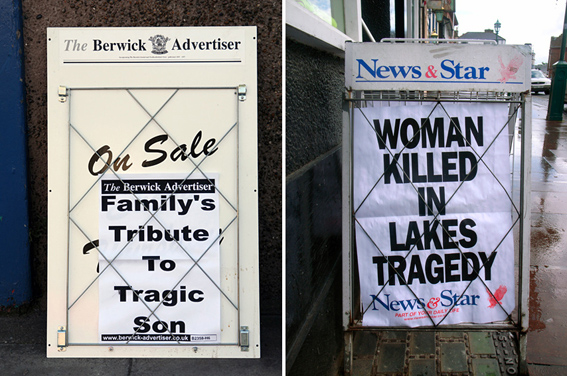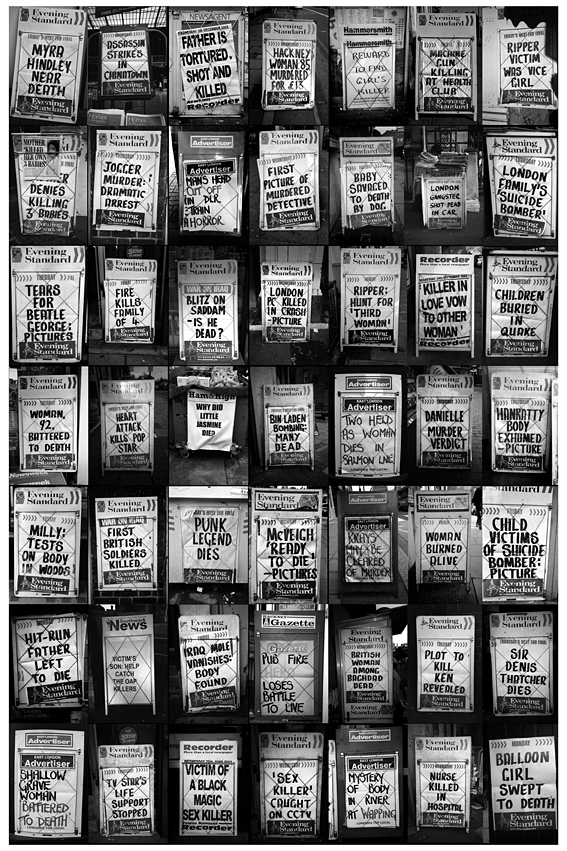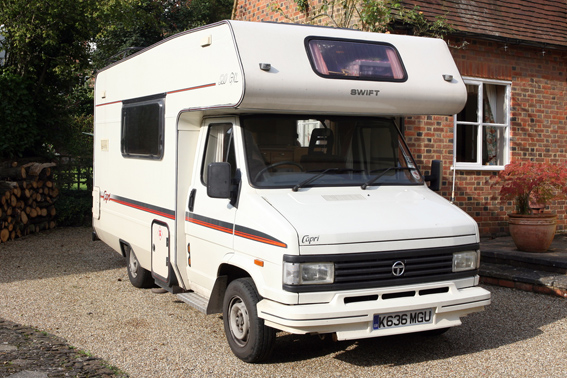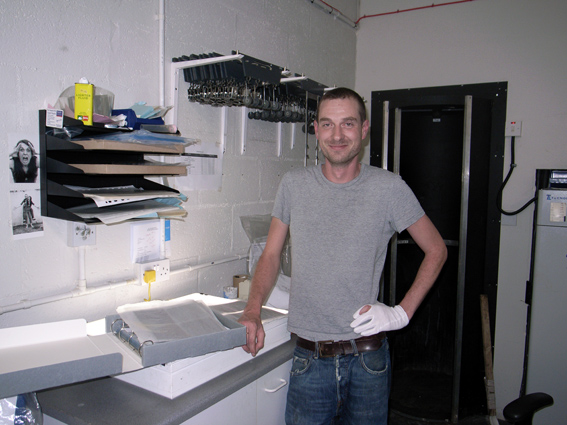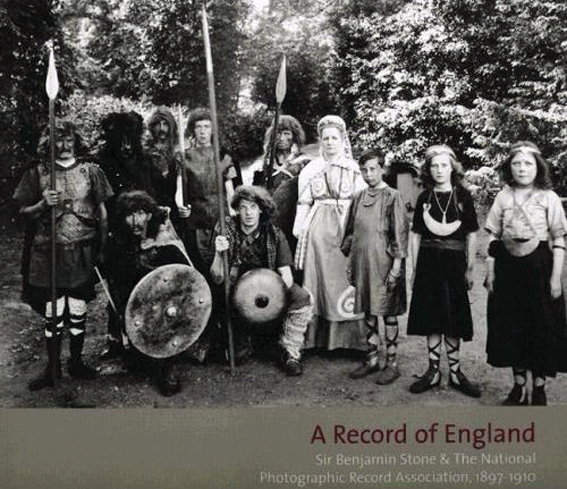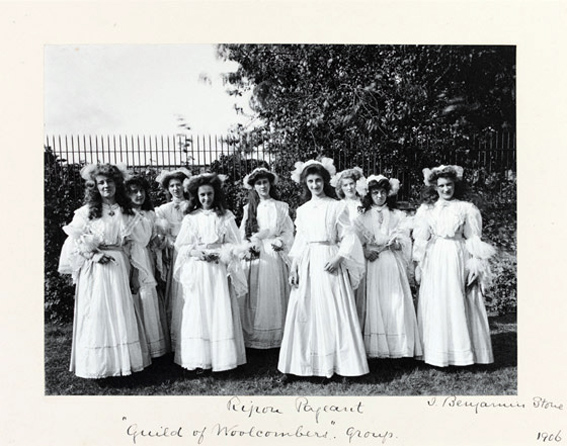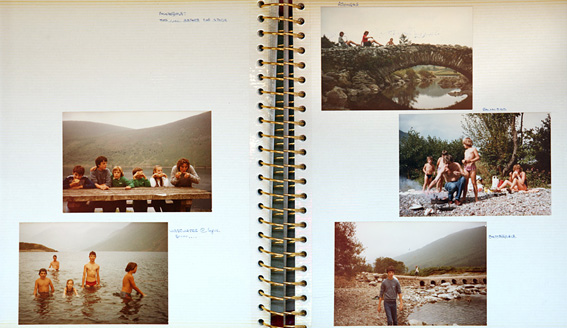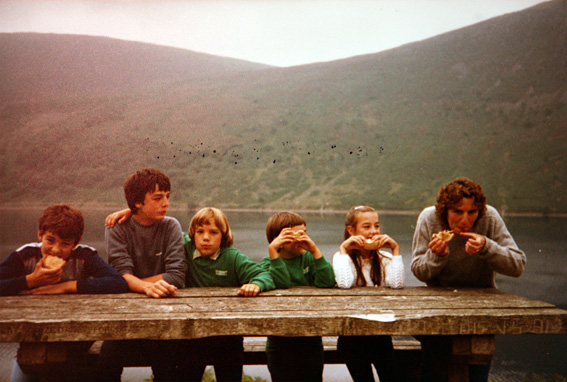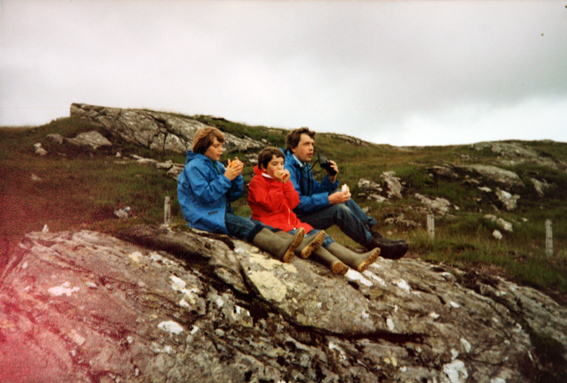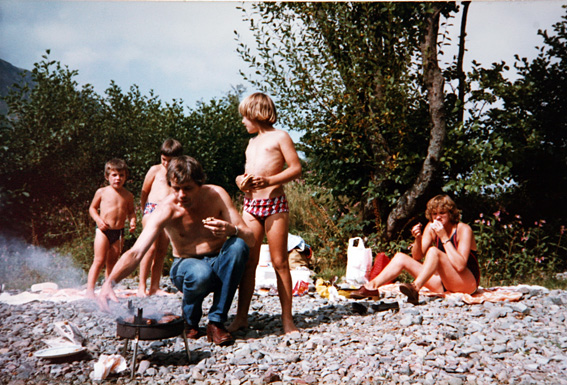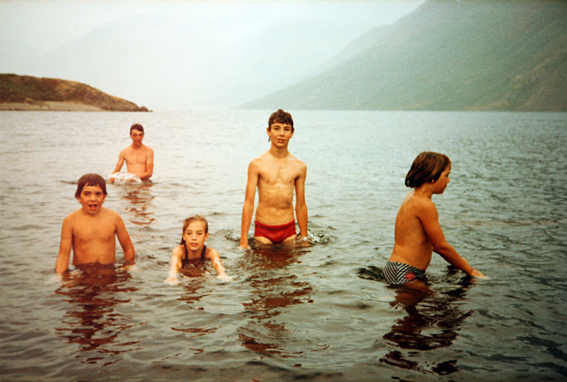September 30th, 2008 admin
Here it is, a pile of contact sheets that represent the fruits of my labour from the past six months. Amongst the few hundred frames I’ve shot (about 1500 to be precise), I now have to tease out a coherent selection of photographs. I’ve had a quick scan through them and I’m trying not to let the wave of ‘contact-sheet depression’ set in. It usually does, and although short lived, it can be quite overpowering! I’ll set them aside for a few days and come back with fresh eyes.
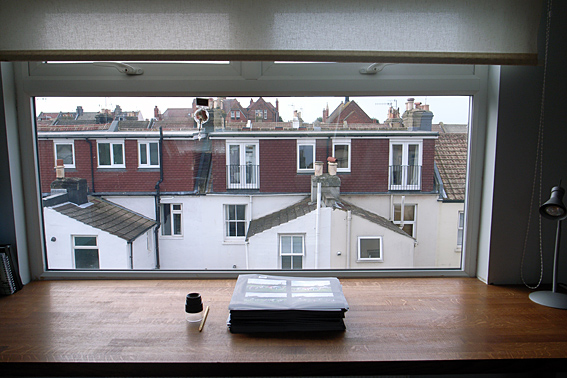
In the meantime, I thought it might be interesting to briefly outline how I normally edit my work. I’ll do this using my first book, Motherland, as a case study. I’ve also pulled out some quotes from other photographers who discuss their approach to editing.
To produce Motherland I shot just over 5000 frames during the course of my year traveling across Russia (for the techies among you, I used a Mamiya 7 camera with Kodak Portra 220 film). Every three months, on my return to Moscow to get a visa extension, I had the film processed and contact sheets made. This enabled me to do some editing during the course of the journey. It also allowed me to evaluate how each stage of the project was developing, what themes were emerging and work out what I needed to be looking for during the next stage of shooting. Critically, it also meant I could check that the camera/ lenses were working properly and that the film hadn’t been fogged by some Soviet-era airport security scanner.
On my return to England I made a wide edit of 500 images from the contact sheets. This selection of images I scanned on an Imacon and then made larger contact sheets. These sheets were then spiral bound into a book. Here are a couple of pages from the book-
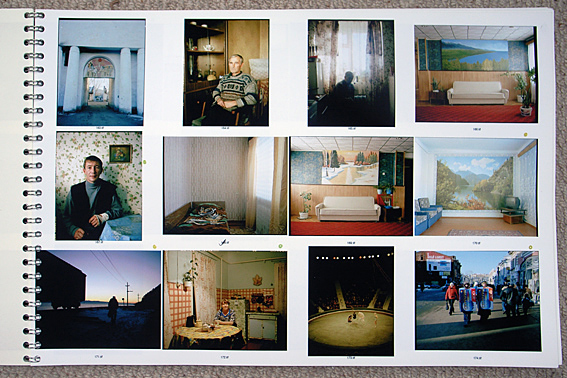
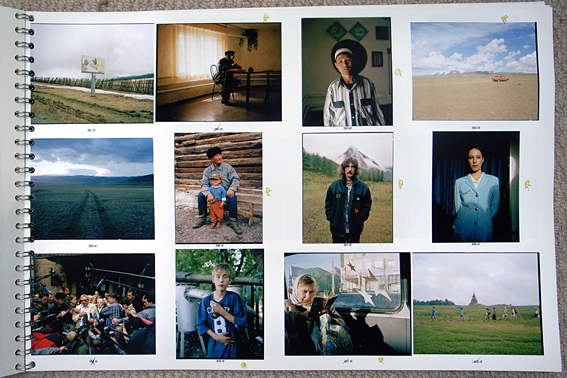
Over the course of a few weeks I would return to the photographs marking those images that I was most interested in. I’d start with a small cross in the top left corner with a yellow chinagraph-
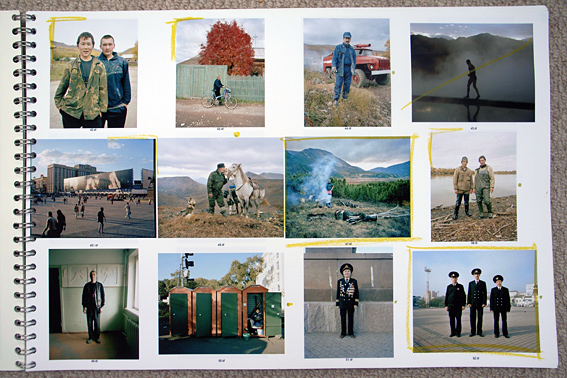
Then finally mark the definitive photographs on all four sides-
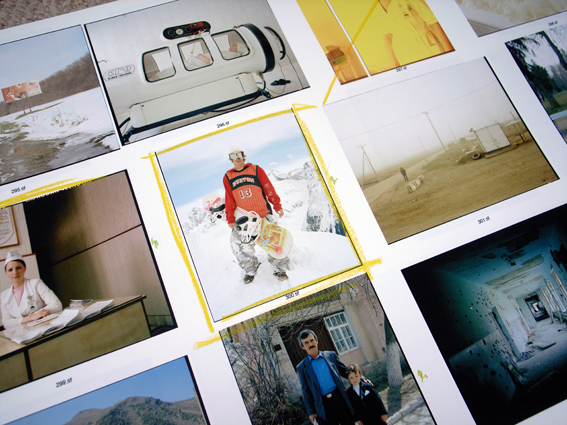
After a couple of months I gradually (and somewhat painfully) whittled the 500 images down to the final book edit of 153 photographs. This was done with the help of some editors, most notably Chris Boot, my publisher. It was critically important that I had an external eye (and someone I trusted and respected) to help with the editing. I was too emotionally attached to the photographs and in several cases wanted to select images that just weren’t strong enough or didn’t fit as a whole.
The final stage was to prepare the 153 scanned photographs, getting the colours correct and doing some slight cleaning up in photoshop. They were then turned into CMYK files for the printers. I also made 10×8 prints of all the photographs which were used for colour matching at the printers.
With regards We English, the editing process will be made slightly easier as the 5×4″ negative is a lovely size to preview, which means I won’t have to scan as many images. Time is also on my side. The book won’t be going into production until Spring next year. I’m envisaging there will be about half the number of photographs in the book than there were for Motherland.Â
Â
Other photographers discuss their approach to editing-
These quotes are taken from the book Image Makers, Image Takers by Anne-Celine Jaeger.
Mary Ellen Mark: “Editing is extremely difficult. It’s taken me a long time to learn how to edit. Teaching has helped me with editing. When I’m editing my own work, I do a first general edit. Someone in my studio then scans my edits and enlarges them to approximately 5×7. We place all the enlarged scans side by side which makes it easier to see which frames are the best. Then I choose the final edit.â€
Martin Parr: “You usually have a hunch, but the great thing about photography is that it’s so unpredictable, so you never quite understand how and when a good photograph comes about. But when editing, I do contact sheets, then machine prints and then select from that.â€
And when asked what makes one image stand out more than another, is it emotional or an intellectual reaction he answers: “It must be intuitive. If it were intellectual, I’d be able to explain what happens. That’s why I’m a photographer. I express myself visually, not verbally.â€
Eugene Richards: “I pretty much know that a photograph is ‘successful’ or not when I take it. So when I’m home from an assignment, what I mostly do is go looking for those ‘successful’ pictures, hoping that I wasn’t kidding myself or that I didn’t screw up.â€
Sebastiao Salgado: “I do a first choice from contact sheets and then do many, many work prints. From that, I then choose an average of six images per film. Then I reduce it down to whatever is needed for the magazine in question. I shoot about two to three hundred rolls of film, if I am away for several months.â€
Rineke Dijkstra: “I scan the negatives and make them bigger so you can see them more. Then I might leave them for two weeks because you need distance to see them properly. It happens to me that I take a picture and I think it doesn’t work at all and then I look at it three years later and I think it’s a great picture. It’s probably linked to having something in mind and being disappointed that your expectations weren’t met.â€
Rankin: “I don’t like editing so I always try to fob it off on to someone else, whether it’s a picture editor or someone in my office. You’ll be surprised what other people can bring to your pictures.â€
Alec Soth: “At the beginning of a project I’ll have all these different pictures, because I don’t know what I’m doing and the themes haven’t emerged. The more trips I make, the more pre-editing goes on. I might see something that’s interesting but it won’t fit in. That’s when taking a picture becomes difficult. I think in terms of a book and try to assemble it in my brain. I might take couple of hundred and then edit that down into a series. In the end it’s about creating a mood.â€
Â
And a few paragraphs taken from On being a photographer – David Hurn/Magnum in conversation with Bill Jay.
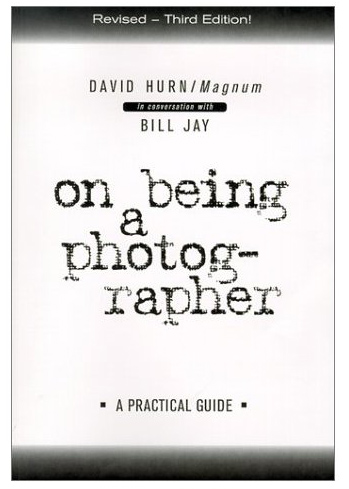
“The myth is that the best photographers are the only ones who have the insight and ability to select the best images of their own work for publication or exhibition.
The myth arises because the photographer is often too close to the subject matter, invests the content with emotion which might not be present in the picture, and believes that in order to be ‘true to myself’ he/she has a special insight into the work. But the best editors of images are those who are capable of divorcing themselves from emotion when judging their own (or others’) work and assessing picture merit dispassionately and with a cold logic.
In the same way that writers are enhanced by a close relationship with a good editor, so a photographer can benefit from the insights of a good picture-editor.
Our advice to photographers is: find an editor you can trust, one who is working at the highest possible level of professionalism.”
Hurn and Jay finish with an instructive example of this myth-
W.Eugene Smith, who became a legend by resigning from Life magazine because he was not allowed full control over picture selection. When he was given the opportunity to edit his own work the results were disastrous, as epitomized by his Pittsburgh essay. He shot over 11,000 negatives in one year (1955), printed 7,000 proofs, and selected 2,000 images. The only publication willing to use the result was Popular Photography Annual, 1958. It used 88 images over 34 pages. Even on Smith’s terms, the whole project was a failure.
Â
Posted in POST PRODUCTION | 22 Comments »
September 27th, 2008 admin
A reader of the blog emailed me today to suggest I looked at roadside memorials as part of the project-
“Dear Sir,
This may seem macabre but there is a whole book just waiting to be written whose subject would be the shrines which have sprung up on roadsides where a loved one has been killed in an accident. Some are attended more regularly than many a grave, with floral tributes frequently restored. Others have grown to iconic proportions with photos and the deceased’s number plate.
All have a tale to tell I’m sure. For starters, if it’s still there, look near the lay by on the A628 near Woodhead between Glossop and Barnsley (the Woodhead pass). It’s just before the lay by which is more like an old quarry entrance and has a snack bar trailer in it. The shrine is in a very dangerous section.”
Although not something I intend covering for We English, I think it’s worth a mention on the blog, especially following on from my post Death, Read All About It, last week.
During our travels we did come across a large number of roadside memorials marking the location of fatal road accidents. These shrines, marked with plaques, wooden crosses and flowers, are considered not only an appropriate but also an expected response to tragedy.
Â
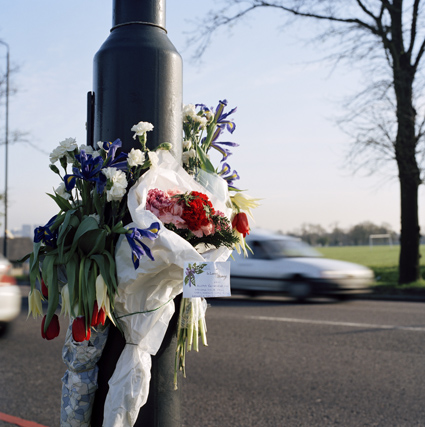
Roadside Memorial, Purley Way, Croydon
The card reads “In Loving Memory, Von – Always Remember You and Always Love, from Cary, Maggie, Chris, Ruth, Lesley and family.”
According to Brake, the road safety charity, while many local authorities are happy for small memorials to be placed at the roadside, some authorities object to permanent memorials, even small ones, and even go as far as restricting the length of time that flowers can be placed at the scene of a crash. Dr Una MacConville from the Centre for Death & Society at University of Bath has undertaken research into these ‘spontaneous shrines’, as she refers to them. She claims that these restrictions are for “health and safety reasons” and authorities are claiming they are acting on foot of advice from the police who fear the tributes, many near dangerous roads, could distract motorists. These restrictions have been considered “crass and insensitive” by bereaved families and road safety campaigners, some of whom feel these memorials are being removed in order not to draw attention to the death toll on certain roads.
One of the most interesting phenomenon related to roadside memorials has been the appearance of Ghost Bikes around England, and abroad. Ghost Bikes are small and somber memorials for bicyclists who are killed or hit on the street. A bicycle is painted all white and locked to a street sign near the crash site, accompanied by a small plaque. The first ghost bikes were created in St. Louis, Missouri in 2003, and they have since appeared in at least 62 cities throughout the world.Â
Â
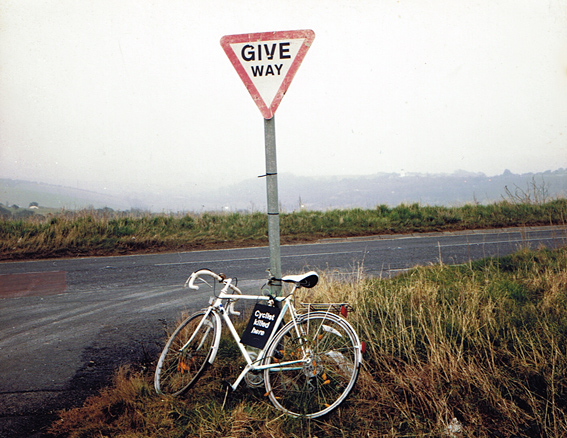
Ghost bike, Brighton
James Danson-Hatcher, 23, was fatally injured when he was hit by a car travelling at about 60mph near a Brighton beauty spot. The accident happened at the junction of Saddlescombe Road and Devil’s Dyke Road, on the outskirts of Brighton, at about 5.30pm on April 5. Mr Danson-Hatcher, was riding home after a visit to Devil’s Dyke when he was hit by a Fiat Bravo. A recent inquest inquest into the accident heard Mr Danson-Hatcher, who had ambitions to be a professional photographer, was described by his family as a competent and experienced cyclist who regularly rode to Devil’s Dyke to cycle across the Downs. His father told the hearing cycling was his son’s main means of transport and leisure activity and said it was a “cruel irony” he died while on his bike.
As the Ghost Bike website quotes “the bikes serve as reminders of the tragedy that took place on an otherwise anonymous street corner, and as quiet statements in support of cyclists’ right to safe travel.”
Posted in MISCELLANEOUS, ON THE JOB | 2 Comments »
September 22nd, 2008 admin
Although I’ve already mentioned Homer Sykes’ work in a recent blog post on Sir Benjamin Stone (Knight of the Camera) I felt his work on traditional British customs warranted it’s own post.Â
Born in Vancouver, Canada, Sykes has been in the UK since 1954 and working as a photographer for over 40 years. It was while studying at the London College of Printing (now LCC) between 1968-71 that he came across the work of Sir Benjamin Stone. A discovery which provided the inspiration for his book ‘Once A Year – Some Traditional British Customs’ (Pub: Gordon Fraser, 1977).

Â
Sykes has described his motivation for Once A Year in an interview on Luminous-Lint–
“I thought it would be interesting to re-photograph some of these customs and others I researched seventy years later, but not in a static way with a large format camera as he had, but in my own style, that I hoped would be a fusion of the American street photography genre that I loved, and had seen in MOMA in New York – Lee Friedlander, Garry Winogrand, Burk Uzzle, Robert Frank, and Bruce Davidson, (because of the way their images appear spontaneous, accidental and stylish) and that of the humanitarian reportage and documentary photography of the great Magnum photographers.
The project lasted 7 years, I travelled all over the country to take these photographs and covered about one hundred traditional events, that for the most part took place once a year. I tended to avoid folk club revival country customs, and those events that seemed to be more to do with town hall tourism than local history. As a young documentary photographer I was interested in the contemporaneity of the participants, the coexistence of ancient and modern, and of course of the documentary value of what I was doing.”
Â
The Burry Man (Jacko Hart), South Queensferry, Lothian, Scotland
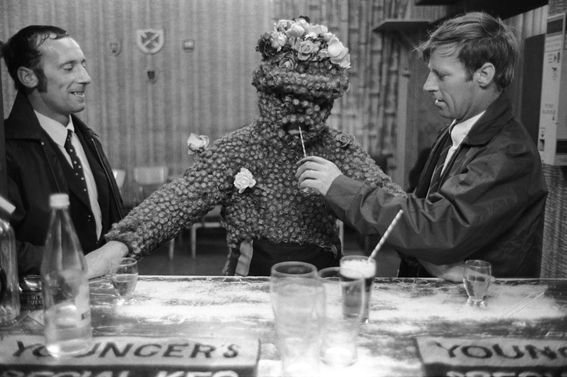
© Homer Sykes, 1971
The Burry Man with his helpers Billy Scott and David Scott in the South Queensferry Ex Servicemans Club taking a break from his perambulations of the towns boundaries (1971). 

There are reports from the nineteenth century of the Burry Man appearing in other Scottish locations when the fishing harvest was failing. The twentieth century Burry Man makes his perambulations of the town boundary on the date preceding the annual Ferry Fair. It is thought that this was once a fishing fertility rite, although these days it is associated with the local borough or burgh. The fair has been in existence since 1687, and now takes place during the second week in August. By 1971 nothing of what was once an eight day fair remained save the road race, run for a traditional pair of black boots.
It’s a beautifully photographed, tender and often humorous document. I’d love to get my hands on a copy. Unfortunately it’s out of print and a used copy will set you back £100. I think I’ll have to wait for the re-print!
For those of you who want to find out more about Skyes’ recent work, you can read an interview from 2007 on the Photo Histories website here. Â
I’ll be interested to know what Sykes thinks of my attempt at documenting England thirty years later, especially given my choice of a “static” large format camera.
Â
Posted in INSPIRATION, RESEARCH | 2 Comments »
September 22nd, 2008 admin

As mentioned in my last post, here are a selection of headlines from regional and local newspapers collected during my travels. They come from a variety of free-sheets, daily and weekly newspapers. I’ve only quoted the main headline and not the subtitle. They are in date order.
Midhurst and Petworth Observer, “Academy twist as heads unite to back moveâ€, 1st May 2008
Reading Evening Post, “Body pulled from riverâ€, 9th May 2008
Gloustershire Echo, “Tracey had a heart of goldâ€, 14th May 2008
Weston & Somerset Mercury, “Crimebusting vicars on callâ€, 15th May 2008
Somerset Guardian, “Journey of terrorâ€, 15th May 2008
Worcester News, “Deep fried pigeonâ€, 16th May 2008
Malvern Gazette, “Marriage made in heaven or recipe for divorceâ€, 16th May 2008
Weekend Citizen, “Supermarkets’ food attackedâ€, 17th May 2008
Western Daily Press, “Pinned down by card scammersâ€, 19th May 2008
Western Daily Press, “£14bn deal secures west defence jobsâ€, 21st May 2008
Burnham & Highbridge Weekly News, “Speedboat owner’s miraculous escapeâ€, 21st May 2008
Devon Journal, “Black Tuesday in north Devonâ€, 22nd May 2008
West Somerset Free Press, “Aquasplash; Rescue bid falls throughâ€, 23rd May 2008
Dorset Echo, “‘Ghost Town’ fears over homesâ€, 26th May 2008
Wilts and Gloucestershire Standard, “Polyclinic threat to GP surgeriesâ€, 29th May 2008
Salisbury Journal, “Super – surgeries plan angers GPsâ€, 29th May 2008
Yeovil Times, “Avril aims to clean up mean streetsâ€, 28th May 2008
Newbury Weekly News, “Driver jailed for friends’ road deathsâ€, 29th May 2008
Gloucestershire Echo, “Flat blaze victim – I’ve lost all I hadâ€, 2nd June 2008
The Advertiser (North Hampshire), “ProLogis plan thrown out, but appeal likelyâ€, 3rd June 2008
Saffron Walden Weekly News, “Plan to bring back police station cellsâ€, 5th June 2008
Melton Times, “New council HQ – two-year waitâ€, 12th June 2008                                            Â
Herne Bay Times, “Goodbye Warrenâ€, 12th June 2008
Evening Telegraph, “Absent Wendy to be kicked outâ€, 12th June 2008
Grantham Journal, “Victimised for being oldâ€, 13th June 2008
The Argus, “Rough justiceâ€, 21st June 2008
Kent on Sunday, “Say goodbye to family GPâ€, 15th June 2008
Thanet Times, “Spy cam to trap vandalsâ€, 17th June 2008
Isle of Wight County Press, “Why can’t we have ferry subsidies?â€, 20th June 2008
Reading Evening Post, “River plunge tot criticalâ€, 26th June 2008
Oxford Journal, “Eco-town charm offensiveâ€, 26th June 2008
Northampton Chronicle, “Did u c incdnt in ur pk?â€, 1st July 2008
Harborough Mail, “Homes anger to reigniteâ€, 3rd July 2008
Hinckley Times, “This is the futureâ€, 3rd July 2008
Hereford Times, “Bulmers: ‘Faults beyond belief’â€, 3rd July 2008                                            Â
Coventry Telegraph, “Playground prowler tries to grab girlâ€, 4th July 2008
Bridgnorth Journal, “Landmark row eruptsâ€, 4th July 2008
Express & Star, “Jobs to go at factoryâ€, 5th July 2008
Leister Mercury, “Grand Prizeâ€, 5th July 2008
Shropshire Star, “PM’s plea on food wastingâ€, 7th July 2008
Macclesfield Express, “Man leaves £1million fortune to churches and charitiesâ€, 9th July 2008
Crewe Chronicle, “Woman is held over deathâ€, 9th July 2008
Nantwich Chronicle, “Thieves strike at churchâ€, 9th July 2008
Echester Evening Leader, “City council workers to strikeâ€, 11th July 2008
Liverpool Echo, “Strike Chaosâ€, 16th July 2008
Ellesmere Port & Neston Standard, “Future of £50m school academies plan hangs in the balanceâ€, 17th July 2008
Bury Times, “Three care homes may shutâ€, 17th July 2008
Formby Times, “Post office survival bidâ€, 17th July 2008
Southport Visitor, “Sex shame of top bossâ€, 18th July 2008
Liverpool Post, “Region reaps benefits of Birkdale bonanzaâ€, 21st July 2008
The Bolton News, “Students ‘killed by meningitis’ on holidayâ€, 22nd July 2008
Lancashire Telegraph, “Classroom pervertâ€, 23rd July 2008
Longridge & Ribble Valley News, “Family mourns tragic mumâ€, 23rd July 2008
Hebden Bridge Times, “Battle to recycle the wasteâ€, 24th July 2008
The Clithroe Advertiser & Times, “Head’s fury at new SATs blunderâ€, 24th July 2008
Batley News, “Minibus death crash – driver questionedâ€, 24th July 2008
Todmorden News, “Filmed up girl’s skirtâ€, 24th July 2008
Wakefield Express, “Bustedâ€, 25th July 2008
Heckmondwike Herald, “Water babyâ€, 25th July 2008
Nelson Leader, “Two die on way to a funeralâ€, 25th July 2008
Burnley Express, “Tragedy of pregnant mum Claireâ€, 25th July 2008
The Gazette, “Life in ruins after attackâ€, 25th July 2008
Dewsbury Reporter, “We’ve got £1.2m to splash outâ€, 25th July 2008
Evening Courier, “Taxi terror thugs cagedâ€, 28th July 2008
The Huddersfield Daily Examiner, “‘Dodgy Lodger’ back in the line of fireâ€, 29th July 2008
Uttoxeter Advertiser, “Armed raidâ€, 30th July 2008
Cheadle Post & Times, “Workers wait in fear as JCB jobs axe looms overâ€, 30th July 2008
Yorkshire Post, “Mortgage squeezes prompts fraud warningâ€, 30th July 2008
Staffordshire Newsletter, “Town’s new pool is closed within hoursâ€, 31st July 2008
Black Country Bugle, “Cutting the cost of living in the thirtiesâ€, 31st July 2008
Buxton Advertiser, “NHS fears £8m gap in budget”, 31st July 2008
Derbyshire Times, “Cannabis grower risks jailâ€, 31st July 2008
Birmingham Mail, “Fury as gas staff run riotâ€, 1st August 2008
Uttoxeter Post & Times, “Fears of economic crisis as employers deliver tripleâ€, 1st August 2008
The Sunderland Sentinel, “Boy racers face ban from the roadsâ€, 4th August 2008
The Sunderland Star, “Landslide owls vote, 7th August 2008
Darlington & Stockton Times, “Appeal to blow opponents of caravan parkâ€, 8th August 2008
The Northern Echo, “Horror in the Alpsâ€, 9th August 2008
Evening Gazette, “Dad killed in freak crashâ€, 11th August 2008
Whitby Gazette, “Bradley’s debt to Lizâ€, 12th August 2008
Scarborough Evening News, “Girl, 6, held hostage in armed siegeâ€, 13th August 2008
Rydale Gazette & Herald, “Crisis talks planned on housing shortageâ€, 13th August 2008
Peterlee Star, “SATS row goes onâ€, 14th August 2008
The Whitehaven News, “OAP fined £80 for stubbing cig in streetâ€, 14th August 2008
Peterlee Mail, “New street booze bansâ€, 15th August 2008
Sunderland Echo, “Drivers pay upâ€, 15th August 2008
The Westmorland Gazette, “Tory leader pledges to support hospitalâ€, 15th August 2008
North West Evening Mail, “Secret millionaire lived in 75K flatâ€, 16th August 2008
Lake District Herald, “Action taken over acrobats ‘cheeky’ town centre actâ€, 23rd August 2008
The Visitor, “Coroner’s plea after hit-and-run tragedyâ€, 27th August 2008
Morpeth Herald, “Thieves strip undies shop of entire stockâ€, 28th August 2008
News & Star, “Power cut will cost thousandsâ€, 28th August 2008
The Whitehaven News, “Is Sellafield hand over under threatâ€, 28th August 2008
Northumberland Gazette, “Green light at stationâ€, 28th August 2008
Morecambe Guardian, “Battling granny goes to the High Courtâ€, 29th August 2008
The Westmorland Gazette, “Damsons in distressâ€, 29th August 2008
The Newcastle Journal, “Builders shelve 1,000 projectsâ€, 1st September 2008                                           Â
Northumberland Gazette, “Braid is savedâ€, 4th September 2008
The Berwick Advertiser, “Report claims climate change could cause havocâ€, 4th September 2008
Pocklington Post, “Man on trial for robbery at shopâ€, 4th September 2008
Kent on Sunday, “Repossessions on the up as credit crunch hits homeâ€, 7th September 2008
The Press, “Stadium dream in jeopardyâ€, 8th September 2008
Evening Chronicle, “Miracle Escapeâ€, 8th September 2008
Lynn News, “Pupil power to back appealâ€, 9th September 2008
Cleethorpes Life, “Why is Teresa Basset turning back the clock?â€, 10th September 2008
Telegraph & Argus, “Drugs addict terrorised elderly in homesâ€, 10th September 2008
Yorkshire Evening Post, “Top solicitor theft chargeâ€, 10th September 2008
East Riding Mail, “Savagedâ€, 10th September 2008
Driffield Times, “Our agonyâ€, 10th September 2008
Grismby Telegraph, “Our kids are ‘bone idle’â€, 10th September 2008
Boston Standard, “Judge socks it to repeat offenderâ€, 10th September 2008
North Norfolk News, “Traders victoryâ€, 11th September 2008
Sevenoaks Chronicle, “Area must have more play parksâ€, 11th September 2008
Brighton and Hove Leader, “Enemy at the gatesâ€, 11th September 2008
Posted in RESEARCH | 1 Comment »
September 19th, 2008 admin
While I’m not generally a fan of photography compendium’s, I recently picked up Image Makers, Image Takers by Anne-Celine Jaeger and found some of the quotes to be quite revealing. The first section of the book is broken up into interviews with photographic artists, working within the disciplines of fine art, documentary, fashion, advertising and portraiture, where they are asked about what inspires them, the balance of technique and gift and the process of artistic creation. The second section has picture editors, curators, agency directors and art book publishers interviewed about what they look for in an image.
Â
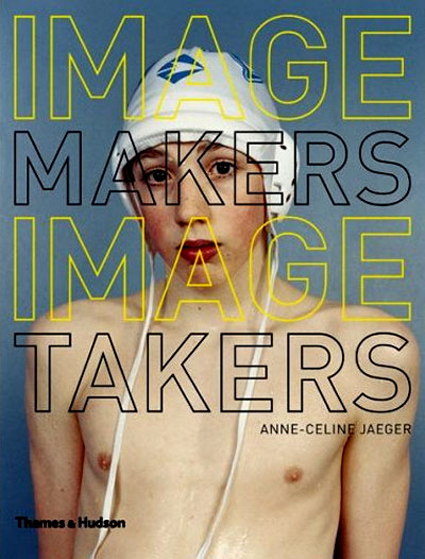
Here are some of the quotes-
William Eggleston is asked “How do you decide if something is worthy of being captured?”
“I never know beforehand. Until I see it. It just happens all at once. I take a picture very quickly and instantly forget about it. Not for good, but for the time being. Suddenly I just feel like I have to take a picture. Sometimes I’ll leave the house with a fully loaded camera and end up with nothing. It’s just about being there. Anywhere. Even the most uninteresting, ugly or boring places can for an instant become magical to me.”
William Eggleston quotes Garry Winogrand-
“When someone asked him why he took pictures, Garry said, ‘Because I want to see what something looks like when it’s photographed.'”
Stephen Shore is asked “Do you need a philosophy to do great work?”
“I would call it ‘intentionality’. Sometimes I meet young artists and it becomes clear that for some the main motivation is getting a show in Chelsea. It strikes me that this is very different to the way it was for me, which was that I wanted to understand photography and the world and myself. To do that, I produced work. The work that was shown was like a by-product, but never the purpose of my photography. The thought process doesn’t even have to be conceptual or intellectual. It can be visual, or a layer of thought that’s wordless. I’m always exploring some question or other, but it may not even be formulate as such. I believe the work produced by most established artists, was produced as a by-product of their personal explorations.”
Eugene Richards is asked “Do you see yourself more as a photographer or a journalist?”
“I go out into the world as a photographer, but I were to tell the truth, if I could become a very fine writer, I wouldn’t need to take photographs any more.”
David LaChapelle is asked “Do you think you can learn a way of seeing?”
“I think you either have it or you don’t. If you have it, you have to discipline yourself to prove it.”
Alec Soth is asked “Are you ever in the situation where you think I’m not sure that was in focus but you have to let it go?”
“All the time. It’s the bane of my existence. I miss pictures all the time. It kills me. But I’m technically better now and I also shoot more film, so I have better odds. I also have this problems that I try to get too much into a picture. I have to remind myself that photography is about limitation. It’s about not having everything there.”
William Eggleston is asked “What goes through your mind when you are framing a shot”?
“Nothing really. It happens so fast. I compose very quickly and without thinking, but conciously. I take a picture instantly and never more than one. Sometimes I worry about the picture being out of focus, but I take the chance. A long time ago, I would have taken several shots of the same thing, but I realised that I could never decide which one was the best shot. I thought I was wasting a lot of time looking at the damn near identical pictures. I wanted to discipline myself to take only one picture of something, and it didn’t work out, that’s just too bad. But it’s pretty much always worked.”
Martin Parr is asked “What are you thinking about, for example, when you are taking a picture in New Brighton of a young mother and kids eating chips opposite an over-flowing dustbin?”
“I’m thinking, ‘Here’s a family on their day out and the litter is spewing over because it’s a bank holiday weekend.'” (!?)
Posted in MISCELLANEOUS | 3 Comments »













